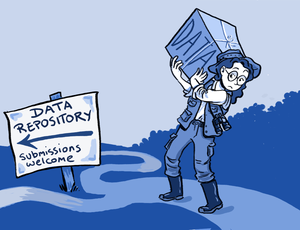Agencies fail to deliver a plan to deliver the data

It’s been more than four and a half years since the Obama administration issued its Open Government Directive in December 2009. By far one of the broadest open government initiatives in the world, one of the key components in the execution of the Open Government Directive is the biennial publication of agencies’ Open Government Plans, which provide concrete goals and benchmarks for making open and transparent government a reality.
The plans, which were supposed to be published online by June 1, 2014, should include information on implementation of key features of the administration’s open data policy, including the creation and publication of Enterprise Data Inventories (EDIs), listings of all agency data holdings. We’ve argued elsewhere that EDI publication is a critical component of transparency — for one thing, you can’t ask for data that you don’t know exists.
But there’s one small problem.
While experience has taught us that showing up isn’t quite half the battle, it’s even more disappointing to find that some federal agencies haven’t even done that. Open the Government, along with other members of the open government community have been keeping an eye out for new plans over the past month, and we’re disappointed to find that eight of the 29 executive branch agencies that are required to have yet to publish their their new plans.

The Department of Health and Human Services, whose 2012 Open Government Plan was one of the most complex and detailed ones out there, seems to have dropped the ball on rolling out version 3.0 at a time when their data holdings are poised to be larger and more important than ever before. We’re looking forward to hearing from them about how they plan on managing the enormous online disclosures of data generated by the provisions of the Affordable Care Act.
The State Department, whose under secretary of state for management has most recently come under fire for its perennially lax oversight of government contractors, has also neglected to deliver a comprehensive open government plan. Although State has published an Open Data Plan that provides timelines for the creation of its EDI and the release of future datasets, the Open Government Plan would provide more information about the scandal-prone department’s broader transparency efforts.
Perversely enough, the Office of Management and Budget (OMB), the agency tasked with implementation of many open government initiatives, has missed its own deadline. While OMB indicated earlier this year that their Open Government Plan might be late, they haven’t since provided a revised timeline for publication. Other divisions in the Executive Office of the President have been lagging, too: Neither the Council on Environmental Quality nor the Office for National Drug Control Policy has published new plans since the first 2010 deadline. The Small Business Administration and the Agency for International Development, both independent agencies subject to OMB review, haven’t published their new plans either.
Last, but certainly not least, the beleaguered Department of Veterans’ Affairs has missed its second Open Government Plan deadline. While the agency released its first plan in June 2010, it has failed to publish its plan in compliance with either the April 2012 or June 2014 deadlines. Although the VA has responded to its ongoing waitlist scandal by releasing data online, it’s just as important to build the long-term infrastructure for making its data transparent and available in the months and years to come. Reforming the VA with a concrete and up-to-date plan will help watchers inside and outside the VA hold them accountable for enacting any promised reforms.
At the end of the day, this is why having Open Government Plans are important: because long after the controversy and political impetus for disclosure has faded, the need for high quality public data — often data that only governments are positioned to collect and provide—will remain.

